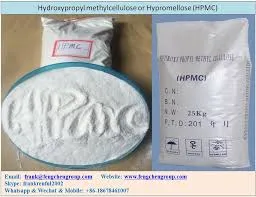
Ное . 24, 2024 15:03 Back to list
Preparation Methods for HPMC Gel and Its Applications in Various Fields
Preparation of HPMC Gel A Comprehensive Guide
Hydroxypropyl Methylcellulose (HPMC) is a versatile polymer derived from cellulose, widely used in various industries, including pharmaceuticals, cosmetics, and food. One of its most popular applications is in the preparation of gels. HPMC gels are valued for their thickening, gelling, and stabilizing properties, making them ideal for numerous formulations. This article provides a comprehensive guide to the preparation of HPMC gel, highlighting key considerations and steps involved in the process.
Understanding HPMC
HPMC is a non-ionic, water-soluble polymer that is characterized by its ability to form viscous solutions and gels when dissolved in water. It is an excellent choice for gel formulations due to its low toxicity, biodegradability, and compatibility with various additives. HPMC gels can be tailored to meet specific requirements, such as viscosity, texture, and release characteristics, making them suitable for applications ranging from topical formulations to controlled drug release systems.
Materials Required
To prepare HPMC gel, the following materials are typically required
1. HPMC Powder The choice of HPMC grade will depend on the desired viscosity and gel characteristics. Higher viscosity grades provide thicker gels, while lower viscosity grades create more fluid formulations.
2. Water Distilled water is recommended to ensure the purity of the gel. The temperature and quality of the water can significantly impact the dissolution of HPMC.
3. Additives (optional) Depending on the intended application, additives such as preservatives, fragrance, colorants, or active pharmaceutical ingredients (APIs) may be included.
4. Equipment A mixing vessel, stirring device, and measuring tools are essential for the preparation process.
Steps to Prepare HPMC Gel
hpmc gel preparation

1. Determine the Concentration The concentration of HPMC in the gel is crucial. Typical concentrations range from 1% to 5% w/v, depending on the desired viscosity and application. Higher concentrations yield thicker gels, while lower concentrations result in more fluid formulations.
2. Hydration of HPMC Start by measuring the required amount of HPMC powder. Gradually sprinkle the powder into a predetermined volume of distilled water while stirring continuously. This step is critical to avoid clumping and ensure even dispersion. Allow the mixture to hydrate for at least 30 minutes to an hour, depending on the HPMC grade used.
3. Heating (if necessary) In some cases, gentle heating may be applied to facilitate the dissolution of HPMC. However, care must be taken not to exceed 80°C, as higher temperatures can degrade the polymer.
4. Mixing After hydration, use a stirrer to mix the solution thoroughly. Ensure that all particles are well dispersed and that there are no lumps. The resulting mixture should have a uniform consistency.
5. Incorporating Additives If additional ingredients such as preservatives or APIs are required, they should be added after the HPMC is fully dissolved. Stir the mixture well to ensure even distribution of all components.
6. Cooling and Adjusting Viscosity Upon mixing, allow the gel to cool to room temperature. The viscosity may be adjusted at this stage by adding more water or HPMC to achieve the desired consistency.
7. Quality Control Before finalizing the gel, it is essential to conduct quality control tests. Check for properties such as viscosity, pH, and the absence of lumps or air bubbles.
8. Packaging Once the gel is prepared and meets quality specifications, it should be transferred to appropriate containers. Label the containers with relevant details, including the formulation date and expiration date.
Conclusion
The preparation of HPMC gel is a straightforward process that requires careful consideration of materials, hydration techniques, and mixing methods. The versatility of HPMC allows for a wide range of applications, from pharmaceutical formulations to cosmetic products. By following the steps outlined in this guide, formulators can create high-quality HPMC gels tailored to meet specific needs. As with any formulation process, attention to detail and adherence to quality control protocols are essential for successful gel preparation.
-
Versatile Hpmc Uses in Different Industries
NewsJun.19,2025
-
Redispersible Powder's Role in Enhancing Durability of Construction Products
NewsJun.19,2025
-
Hydroxyethyl Cellulose Applications Driving Green Industrial Processes
NewsJun.19,2025
-
Exploring Different Redispersible Polymer Powder
NewsJun.19,2025
-
Choosing the Right Mortar Bonding Agent
NewsJun.19,2025
-
Applications and Significance of China Hpmc in Modern Industries
NewsJun.19,2025







